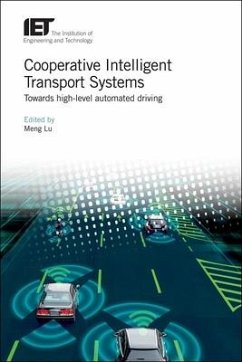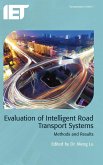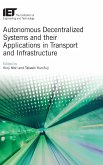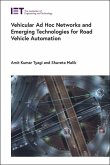Cooperative Intelligent Transport Systems
Towards High-Level Automated Driving
Herausgeber: Lu, Meng
Cooperative Intelligent Transport Systems
Towards High-Level Automated Driving
Herausgeber: Lu, Meng
- Gebundenes Buch
- Merkliste
- Auf die Merkliste
- Bewerten Bewerten
- Teilen
- Produkt teilen
- Produkterinnerung
- Produkterinnerung
The book provides a comprehensive insight in the state of the art of C-ITS and automated driving, especially addresses the role of ICT (Information and Communication Technologies) infrastructure, and presents the main achievements (both theory and practice), as well as the challenges in the domain in Europe, the US and Asia/Pacific.
Andere Kunden interessierten sich auch für
![Evaluation of Intelligent Road Transport Systems Evaluation of Intelligent Road Transport Systems]() Evaluation of Intelligent Road Transport Systems190,99 €
Evaluation of Intelligent Road Transport Systems190,99 €![Cybersecurity in Transport Systems Cybersecurity in Transport Systems]() Cybersecurity in Transport Systems160,99 €
Cybersecurity in Transport Systems160,99 €![Autonomous Decentralized Systems and Their Applications in Transport and Infrastructure Autonomous Decentralized Systems and Their Applications in Transport and Infrastructure]() Autonomous Decentralized Systems and Their Applications in Transport and Infrastructure165,99 €
Autonomous Decentralized Systems and Their Applications in Transport and Infrastructure165,99 €![Energy Systems for Electric and Hybrid Vehicles Energy Systems for Electric and Hybrid Vehicles]() Energy Systems for Electric and Hybrid Vehicles195,99 €
Energy Systems for Electric and Hybrid Vehicles195,99 €![Road Pricing Road Pricing]() Road Pricing218,99 €
Road Pricing218,99 €![Vehicular Ad Hoc Networks and Emerging Technologies for Road Vehicle Automation Vehicular Ad Hoc Networks and Emerging Technologies for Road Vehicle Automation]() Amit Kumar TyagiVehicular Ad Hoc Networks and Emerging Technologies for Road Vehicle Automation176,99 €
Amit Kumar TyagiVehicular Ad Hoc Networks and Emerging Technologies for Road Vehicle Automation176,99 €![AI Techniques in Ev Motor and Inverter Fault Detection and Diagnosis AI Techniques in Ev Motor and Inverter Fault Detection and Diagnosis]() Yihua HuAI Techniques in Ev Motor and Inverter Fault Detection and Diagnosis156,99 €
Yihua HuAI Techniques in Ev Motor and Inverter Fault Detection and Diagnosis156,99 €-
-
-
The book provides a comprehensive insight in the state of the art of C-ITS and automated driving, especially addresses the role of ICT (Information and Communication Technologies) infrastructure, and presents the main achievements (both theory and practice), as well as the challenges in the domain in Europe, the US and Asia/Pacific.
Hinweis: Dieser Artikel kann nur an eine deutsche Lieferadresse ausgeliefert werden.
Hinweis: Dieser Artikel kann nur an eine deutsche Lieferadresse ausgeliefert werden.
Produktdetails
- Produktdetails
- Verlag: Institution of Engineering & Technology
- Seitenzahl: 648
- Erscheinungstermin: 10. Dezember 2019
- Englisch
- Abmessung: 240mm x 169mm x 36mm
- Gewicht: 1216g
- ISBN-13: 9781839530128
- ISBN-10: 183953012X
- Artikelnr.: 58409841
- Herstellerkennzeichnung
- Libri GmbH
- Europaallee 1
- 36244 Bad Hersfeld
- gpsr@libri.de
- Verlag: Institution of Engineering & Technology
- Seitenzahl: 648
- Erscheinungstermin: 10. Dezember 2019
- Englisch
- Abmessung: 240mm x 169mm x 36mm
- Gewicht: 1216g
- ISBN-13: 9781839530128
- ISBN-10: 183953012X
- Artikelnr.: 58409841
- Herstellerkennzeichnung
- Libri GmbH
- Europaallee 1
- 36244 Bad Hersfeld
- gpsr@libri.de
1. Part I: Introduction
* Chapter 1: ICT-based cooperative ITS: towards automated road
transport
2. Part II: General aspects of connected, cooperative and automated road
transport
* Chapter 2: Deployment of C-ITS: a review of global initiatives
* Chapter 3: Architecture of cooperative intelligent transport systems
* Chapter 4: Business-model innovation in the smart mobility domain
* Chapter 5: Driving automation and its effects on drivers - a human
factor perspective
* Chapter 6: Legal frameworks and strategies of regulatory authorities
3. Part III: V2X communication for cooperative and automated driving
* Chapter 7: Vehicular communication - a technical review
* Chapter 8: Connectivity for automated driving - an overview on
corresponding R&D activities in Europe
* Chapter 9: Standardisation and V2X implementation
* Chapter 10: Assessment of C-ITS network performance scalability and
transferability
* Chapter 11: 5G for road safety services
4. Part IV: ICT infrastructure for automated driving and future traffic
management
* Chapter 12: Cooperative system integration
* Chapter 13: ICT infrastructure for automated driving
* Chapter 14: Road infrastructure taxonomy for connected and automated
driving
* Chapter 15: Infrastructure-assisted automated driving in transition
areas
* Chapter 16: Connected and automated road transport from the
perspective of cities
5. Part V: Automated driving: market, impacts, roadmap, data quality and
driver aspects
* Chapter 17: The evolution towards automated driving - Insights from
market penetration surveys in Germany
* Chapter 18: Impact assessment of cooperative and automated vehicles
* Chapter 19: Deployment of highly automated driving up to 2040 - case
Finland
* Chapter 20: A practical approach for defining and assessing data
quality in automated driving
* Chapter 21: Dynamic Bayesian networks for driver-intention
recognition based on the traffic situation
6. Part VI: R&D and applications of connected, cooperative and automated
driving outside Europe
* Chapter 22: Recent advances in cooperative and automated driving in
Japan and how we approach these technologies
* Chapter 23: Promoting connected and automated vehicles with
cooperative sensing and control technology
* Chapter 24: Connected and automated vehicle research and development
in the United States
* Chapter 25: Mobility-on-demand using autonomous vehicles: systems,
solutions and challenges
7. Part VII: Discussion and conclusions
* Chapter 26: Cooperative and automated road transport: ambitions,
challenges and key findings
* Chapter 1: ICT-based cooperative ITS: towards automated road
transport
2. Part II: General aspects of connected, cooperative and automated road
transport
* Chapter 2: Deployment of C-ITS: a review of global initiatives
* Chapter 3: Architecture of cooperative intelligent transport systems
* Chapter 4: Business-model innovation in the smart mobility domain
* Chapter 5: Driving automation and its effects on drivers - a human
factor perspective
* Chapter 6: Legal frameworks and strategies of regulatory authorities
3. Part III: V2X communication for cooperative and automated driving
* Chapter 7: Vehicular communication - a technical review
* Chapter 8: Connectivity for automated driving - an overview on
corresponding R&D activities in Europe
* Chapter 9: Standardisation and V2X implementation
* Chapter 10: Assessment of C-ITS network performance scalability and
transferability
* Chapter 11: 5G for road safety services
4. Part IV: ICT infrastructure for automated driving and future traffic
management
* Chapter 12: Cooperative system integration
* Chapter 13: ICT infrastructure for automated driving
* Chapter 14: Road infrastructure taxonomy for connected and automated
driving
* Chapter 15: Infrastructure-assisted automated driving in transition
areas
* Chapter 16: Connected and automated road transport from the
perspective of cities
5. Part V: Automated driving: market, impacts, roadmap, data quality and
driver aspects
* Chapter 17: The evolution towards automated driving - Insights from
market penetration surveys in Germany
* Chapter 18: Impact assessment of cooperative and automated vehicles
* Chapter 19: Deployment of highly automated driving up to 2040 - case
Finland
* Chapter 20: A practical approach for defining and assessing data
quality in automated driving
* Chapter 21: Dynamic Bayesian networks for driver-intention
recognition based on the traffic situation
6. Part VI: R&D and applications of connected, cooperative and automated
driving outside Europe
* Chapter 22: Recent advances in cooperative and automated driving in
Japan and how we approach these technologies
* Chapter 23: Promoting connected and automated vehicles with
cooperative sensing and control technology
* Chapter 24: Connected and automated vehicle research and development
in the United States
* Chapter 25: Mobility-on-demand using autonomous vehicles: systems,
solutions and challenges
7. Part VII: Discussion and conclusions
* Chapter 26: Cooperative and automated road transport: ambitions,
challenges and key findings
1. Part I: Introduction
* Chapter 1: ICT-based cooperative ITS: towards automated road
transport
2. Part II: General aspects of connected, cooperative and automated road
transport
* Chapter 2: Deployment of C-ITS: a review of global initiatives
* Chapter 3: Architecture of cooperative intelligent transport systems
* Chapter 4: Business-model innovation in the smart mobility domain
* Chapter 5: Driving automation and its effects on drivers - a human
factor perspective
* Chapter 6: Legal frameworks and strategies of regulatory authorities
3. Part III: V2X communication for cooperative and automated driving
* Chapter 7: Vehicular communication - a technical review
* Chapter 8: Connectivity for automated driving - an overview on
corresponding R&D activities in Europe
* Chapter 9: Standardisation and V2X implementation
* Chapter 10: Assessment of C-ITS network performance scalability and
transferability
* Chapter 11: 5G for road safety services
4. Part IV: ICT infrastructure for automated driving and future traffic
management
* Chapter 12: Cooperative system integration
* Chapter 13: ICT infrastructure for automated driving
* Chapter 14: Road infrastructure taxonomy for connected and automated
driving
* Chapter 15: Infrastructure-assisted automated driving in transition
areas
* Chapter 16: Connected and automated road transport from the
perspective of cities
5. Part V: Automated driving: market, impacts, roadmap, data quality and
driver aspects
* Chapter 17: The evolution towards automated driving - Insights from
market penetration surveys in Germany
* Chapter 18: Impact assessment of cooperative and automated vehicles
* Chapter 19: Deployment of highly automated driving up to 2040 - case
Finland
* Chapter 20: A practical approach for defining and assessing data
quality in automated driving
* Chapter 21: Dynamic Bayesian networks for driver-intention
recognition based on the traffic situation
6. Part VI: R&D and applications of connected, cooperative and automated
driving outside Europe
* Chapter 22: Recent advances in cooperative and automated driving in
Japan and how we approach these technologies
* Chapter 23: Promoting connected and automated vehicles with
cooperative sensing and control technology
* Chapter 24: Connected and automated vehicle research and development
in the United States
* Chapter 25: Mobility-on-demand using autonomous vehicles: systems,
solutions and challenges
7. Part VII: Discussion and conclusions
* Chapter 26: Cooperative and automated road transport: ambitions,
challenges and key findings
* Chapter 1: ICT-based cooperative ITS: towards automated road
transport
2. Part II: General aspects of connected, cooperative and automated road
transport
* Chapter 2: Deployment of C-ITS: a review of global initiatives
* Chapter 3: Architecture of cooperative intelligent transport systems
* Chapter 4: Business-model innovation in the smart mobility domain
* Chapter 5: Driving automation and its effects on drivers - a human
factor perspective
* Chapter 6: Legal frameworks and strategies of regulatory authorities
3. Part III: V2X communication for cooperative and automated driving
* Chapter 7: Vehicular communication - a technical review
* Chapter 8: Connectivity for automated driving - an overview on
corresponding R&D activities in Europe
* Chapter 9: Standardisation and V2X implementation
* Chapter 10: Assessment of C-ITS network performance scalability and
transferability
* Chapter 11: 5G for road safety services
4. Part IV: ICT infrastructure for automated driving and future traffic
management
* Chapter 12: Cooperative system integration
* Chapter 13: ICT infrastructure for automated driving
* Chapter 14: Road infrastructure taxonomy for connected and automated
driving
* Chapter 15: Infrastructure-assisted automated driving in transition
areas
* Chapter 16: Connected and automated road transport from the
perspective of cities
5. Part V: Automated driving: market, impacts, roadmap, data quality and
driver aspects
* Chapter 17: The evolution towards automated driving - Insights from
market penetration surveys in Germany
* Chapter 18: Impact assessment of cooperative and automated vehicles
* Chapter 19: Deployment of highly automated driving up to 2040 - case
Finland
* Chapter 20: A practical approach for defining and assessing data
quality in automated driving
* Chapter 21: Dynamic Bayesian networks for driver-intention
recognition based on the traffic situation
6. Part VI: R&D and applications of connected, cooperative and automated
driving outside Europe
* Chapter 22: Recent advances in cooperative and automated driving in
Japan and how we approach these technologies
* Chapter 23: Promoting connected and automated vehicles with
cooperative sensing and control technology
* Chapter 24: Connected and automated vehicle research and development
in the United States
* Chapter 25: Mobility-on-demand using autonomous vehicles: systems,
solutions and challenges
7. Part VII: Discussion and conclusions
* Chapter 26: Cooperative and automated road transport: ambitions,
challenges and key findings








